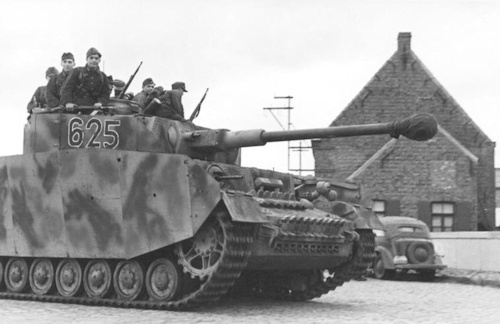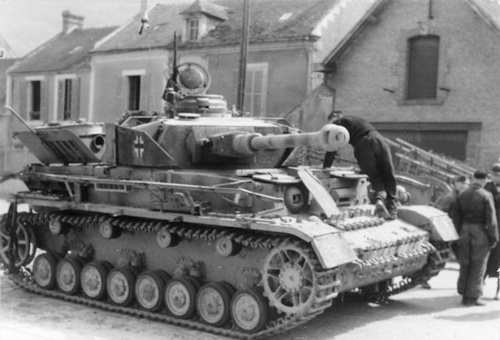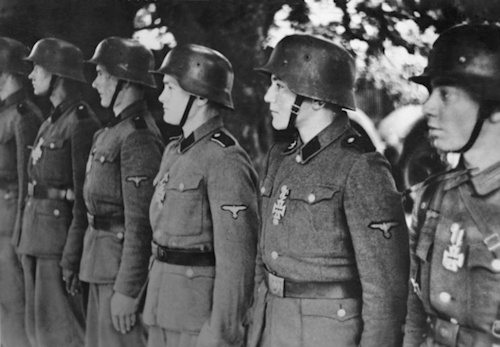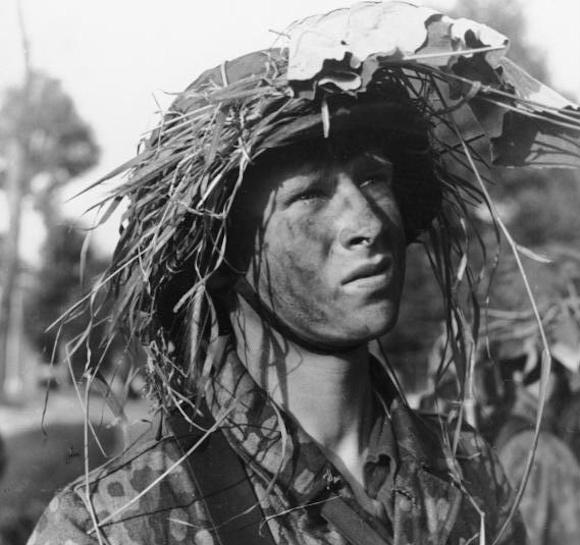On the morning of 6 June 1944, by order of the Supreme Army Command (Oberkommando der Wehrmacht, OKW), the 12ᵃ Panzer Hitlerjugend Division is transferred from the reserve to the Armed B Group, under the command of Field Marshal Rommel.
The orders are to concentrate east of Lisieux, at the 7ᵃ Armata.
The Hitlerjugend was born in Antwerp on July 20 1943, from the merger of some groups of the 1ᵃ Divisione SS Panzer Leibstandarte Adolf Hitler with formations of the Hitlerjugend (Hitler Youth), to go and set up a new panzer grenadier division, framed in the 1o Army Corps Tanks. Most of the officers and non-commissioned officers are chosen from the veterans of the Leibstandarte, returning from the Russian front, and they are entrusted with the training of young recruits.
The Division has a panzer regiment, consisting of two armored battalions (one equipped with heavy tanks) Panther and the other with the PzKpfw IV medium tanks); a counter-battle tank; two panzergrenadier regiments, with three battalions each; an artillery regiment; plus support units.
The numerical strength of its staff is a little higher than the standard divisional organic numbers of the SS (20.540 between officers, non-commissioned officers and troops). The average age of the 1 ° Battalion of the 25 ° Regiment SS Panzergrenadier is of 18 years, and only the 3% have more than 25 years.
 It is precisely the units of the 1 ° Battaglione that moved at 10.00 of 6 June, together with the 26 ° Regiment SS Panzergrenadier, and the 2 ° Battalion with the 25 ° Regiment SS Panzergrenadier.
It is precisely the units of the 1 ° Battaglione that moved at 10.00 of 6 June, together with the 26 ° Regiment SS Panzergrenadier, and the 2 ° Battalion with the 25 ° Regiment SS Panzergrenadier.
These forces arrive in the Lisieux area at 15.00, however they are ordered to concentrate west of Caen, to participate in a counterattack towards the positions held by Canadian troops. The other units of the Hitlerjugend arrived in the operation area in the following 24 hours.
In the absence of an air cover by the Luftwaffe, the 12ᵃ Division is exposed to grazing attacks conducted by the RAF Hawker Typhoons, using rockets and canes.
Due to the pounding Allied air strikes, the 2 ° Battalion, on the morning of June 7, is able to deploy only 50 wagons, while the Panther of the 1 ° Battalion remain stuck on the eastern bank of the Orne river due to lack of fuel.
Consequently, the B Army Group cannot deploy the entire 12 Division Hitlerjugend, constituting only one Kampfgruppe at the orders of Kurt Meyer said Panzermeyer. Therefore, despite the losses suffered in men and materials, the units of the Hitlerjugend, together with the 21ᵃ Panzer Division, are the only forces capable of organizing a counterattack west of Caen.
 The orders given the June 7 foresee a deep attack against the enemy to push him back to the sea. In reality, Meyer decides to stand in defense of Caen, in the hope of receiving reinforcements. As a result, he deploys all three panzergrenadier battalions, with two cart companies on either side and the artillery behind the front line, preparing an ambush for Canadian troops advancing from tests di bridge Allied.
The orders given the June 7 foresee a deep attack against the enemy to push him back to the sea. In reality, Meyer decides to stand in defense of Caen, in the hope of receiving reinforcements. As a result, he deploys all three panzergrenadier battalions, with two cart companies on either side and the artillery behind the front line, preparing an ambush for Canadian troops advancing from tests di bridge Allied.
To get an optimal view, Meyer positions himself on the tower of the Ardennes abbey, studying the best moment for the attack.
Canadians advance through the village of Franqueville, in the direction of Caen airport. When the Canadian tank vanguard is only a hundred meters from the German lines, the PzKpfw IV and the panzergrenadier come out of their hiding places, penetrating deep into the Canadians' side, while the counter-squads begin to hit the armored vehicles.
The young German panzergrenadier fight with such fury that the enemy line begins to falter under their attack. In a few hours the villages of Authie and Franqueville are regained. The German maneuver is successful thanks to the perfect coordination between tanks, panzergrenadier and artillery.
 Later Kurt Meyer was able to declare that the push towards the sea was exhausted due to the lack of fuel and ammunition: but the truth is that it was blocked by the overwhelming air superiority of the Allies.
Later Kurt Meyer was able to declare that the push towards the sea was exhausted due to the lack of fuel and ammunition: but the truth is that it was blocked by the overwhelming air superiority of the Allies.
Although the German counterattack fails to reach the sea, it still prevents the Canadians from conquering the important landing strip of Carpiquet. Canadians lose over clashes over 300 men and 30 tanks are destroyed, while the Hitlerjugend laments the loss of 200 men and 6 carts.
In his first battle the Division fought with extreme courage, impressing his opponents. He suffered heavy losses, but this is considered normal for a special division of the SS.
Finally the 8 June comes a wagon company Panther of the 1 ° Battalion and launched a night attack along the Caen-Bayeux road together with a group of panzergrenadier. The wagons move in a wedge formation, with the panzergrenadier clinging to the turrets. At midnight, the village of Rots was reached, but after a few hours of confused fighting the Hitlerjugend was forced to withdraw after losing six wagons.
The German attack certainly did not lack determination, but tactical control was insufficient, and Canadian observers realize that the Hitlerjugend are launching attacks that are too fragmented, dangerously underestimating the enemies' ability to resist.
 The Germans were planning for the 10 June a massive offensive towards the coast, to which the Hitlerjugend should have also participated: the attack does not take place, since in the meantime the Allies have taken the initiative and are pressing on the left side of the Division Panzer Lehr.
The Germans were planning for the 10 June a massive offensive towards the coast, to which the Hitlerjugend should have also participated: the attack does not take place, since in the meantime the Allies have taken the initiative and are pressing on the left side of the Division Panzer Lehr.
On June 16 the divisional command of the Hitlerjugend, about 27 km southwest of Caen, is hit by an aerial bombardment, Witt Division Commander falls along with other officers, his place is taken by Meyer. Losses start to become severe and fuel is scarce, along with ammunition.
North of Caen the panzerers of the Hitlerjugend operate in support of weaker units, such as the 16ᵃ Luftwaffe Field Division.
The 4 July 3ᵃ Canadian Division launches an attack to take over the village and airport of Carpiquet. The first wave of Canadians reported heavy losses due to the German artillery barrage; later two Canadian infantry battalions engaged in a bitter battle with fifty panzergrenadier deployed to defend the village. However, towards evening, the Canadians occupy Carpiquet and the northern area of the airfield, but the Germans retain control of the northern zone.
Between the 4 and the 9 July the Hitlerjugend Division is one of the cornerstones of the German defense of Caen against the offensive of the 1 ° British Army Corps.
 A massive air attack on Caen causes serious losses in the German ranks. Under the guidance of Panzermeyer the Hitlerjunged resists meter by meter at the urgent advance of the English, but in the end they are forced to withdraw after keeping them in check with a few carts and a fistful of panzergrenadier.
A massive air attack on Caen causes serious losses in the German ranks. Under the guidance of Panzermeyer the Hitlerjunged resists meter by meter at the urgent advance of the English, but in the end they are forced to withdraw after keeping them in check with a few carts and a fistful of panzergrenadier.
After the 9 July the Hitlerjunged Division is reduced its shadow, its members are reduced to the consistency of a battalion and only 65 tanks (on 150) are still able to fight.
On the day of the Allied landing the Division's total losses were 60% of its staff (with 20% deaths and 40% injured).
In his book Overlord Max Hastings pays tribute to these young fighters with the words: no training worried the Allies from the beginning to the end of the Normandy campaign, as much as the 12ᵃ SS Panzer.
Photo: Bundesarchiv / Australian War Memorial












